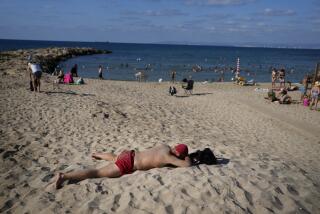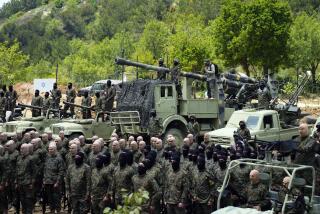In Syria, battle for Damascus is also waged in suburbs
DAMASCUS, Syria — A chaotic passageway through blasted walls, blood-spattered floors and bullet-pocked rooms leads to the narrow stairway where a teenager pokes his Kalashnikov rifle into a sliver of light slicing through the sandbags.
“If we don’t protect our camp, who will?” asked 18-year-old Yehya from his perch on a landing, keeping watch on crumbling apartment blocks and debris-laden streets outside.
The battle for Damascus, the capital, has become a brutal fight for the suburbs. The Syrian army and allied militias are trying to push rebels out of Yarmouk and Dariya in the south, Jobar and Qaboun in the northeast — and kill as many of them as possible. The rebels’ goal is to advance to the seat of power of President Bashar Assad.
It is a street-by-street, building-by-building conflict that grinds on as daily life proceeds in the heart of the city. Traffic police in Damascus still stop motorists for driving without seat belts, garbage trucks pick up the trash, and families flock to festive eateries at dusk after the daily fast during the Islamic holy month of Ramadan.
No one takes much notice of the fighter jets that periodically scream overhead en route to drop their payloads on rebel bastions, or the constant thud of outgoing artillery aimed at opposition-held suburbs. Impossible not to notice are the seemingly countless checkpoints and the occasional car bombs and mortar rounds that strike within the city limits.
Yehya is fighting in Yarmouk, long a thriving settlement that some call the capital of the Palestinian diaspora. Today, it is a largely depopulated battleground where the Syrian military and allied Palestinian militiamen such as Yehya are trying to push out rebels, many of them also Palestinians, who still control most of it.
At times, the battle is personal. The two sides are so close that they can trade insults.
“We are fighting our neighbors, people we know by name,” said Hassoun, 22, a member of a pro-government militia. Like others who were interviewed, he did not want to be identified by his full name for security reasons.
Rebels in Yarmouk move stealthily in a labyrinth of tunnels and paths created by holes blasted in adjoining buildings. The networks can stretch for hundreds of yards and connect with other routes, some of them given numbers for identification purposes.
The pursuing soldiers and militias use the same routes if they capture them.
On Monday, militiamen led visiting journalists along passageways cutting into adjacent buildings and leading to a point close to the front lines.
The route passed through apartments that held traces of their former residents: a picture of a young girl’s birthday party on a wall with a large Tweety Bird superimposed in the background; a pile of well-worn books in a former study conveying a sense of peace and order so at odds with current circumstances. Some rooms were charred and gave off a burnt odor. On occasion, shots rang out.
Bullet casings and spent shells littered the floors. In one alleyway, fighters were trying to repair the motor of a badly damaged Chevrolet Caprice Classic.
All fighters seek to avoid too much time away from the protective cover of buildings and exposed to the ubiquitous snipers. Running and ducking is required in exposed alleyways. Tea breaks are taken in secure areas. Fighters grab sleep on stray mattresses and beds in abandoned apartment buildings, schools and shops.
Each side lobs mortar rounds across the other’s lines. The military also has heavy artillery and aircraft at its disposal. The result has been the utter devastation of broad stretches of suburban Damascus. Still, rebels survive amid the ruins.
The government has said it is making progress. Daily reports boast of success in clearing the capital suburbs and the surrounding countryside of “terrorists,” the government’s term for armed rebels.
On the ground, however, it is hard to judge who has the upper hand. Car bombings and mortar strikes within the city limits appear to have declined, perhaps an indication that the rebels have been pushed back. But major swaths of the suburbs remain no-go zones.
The highway from the capital north to Homs cuts through an apocalyptic gantlet of burned-out, bullet-strafed and collapsed buildings. Thick black smoke rises from fires of uncertain origin. Gunfire crackles. A series of smashed car dealerships hints at what was once a thriving commercial stretch in the town of Harasta. Bullet-riddled vehicles sit stranded along the highway.
“We’ve cleared [more than 750 yards] on each side of the highway, but it’s really not safe to go in because of the snipers,” said a Syrian soldier at a checkpoint on the edge of Qaboun.
Fighting in Yarmouk began in December. Rebels quickly overran much of the Palestinian enclave, and many of its estimated half a million people fled. The army and allied militiamen sealed off the area.
Rebels still hold about 75% of Yarmouk, according to Jumah Abdullah, an official of the pro-government Popular Front for the Liberation of Palestine-General Command. Several thousand civilians remain stranded inside, he said.
“We tried to negotiate to get the armed groups out,” Abdullah said in an interview in an apartment building on the edge of Yarmouk.
“But they wouldn’t leave. So we had to take action,” he said as exploding mortar shells shook the ground.
Abdullah said his group began pushing deeper into the camp in the last week. Fighters said progress had been slow but steady. One fighter said five days of combat had gained 75 to100 yards of ground.
The militiamen have now taken up positions in some of the captured buildings, using the same routes through the walls long traversed by the rebels. Graffiti on the walls extol rebel groups such as the Farouq Brigade and Al Nusra Front, an Al Qaeda-linked faction whose ranks include many foreign fighters, some with combat experience in Iraq or Afghanistan.
“The foreigners have experience and are well-trained,” said one pro-government squad leader known by his nickname Abu Dumoo, or Father of Tears, a short, muscular man in a tank top and black skullcap.
The plan is to push ever deeper into the camp. A major landmark, Reijeh Square, is only about 165 yards away, the pro-government militiamen said.
At strategic points, snipers such as Yehya peered through openings in sandbags and walls, alert for activity in rebel-held buildings and streets and the no man’s land between the two forces. When unused, the openings are plugged with cloth and T-shirts.
The snipers’ slits provide narrow views into the enemy’s territory. Sheets are hung across narrow alleys to provide a measure of cover. A green-and-black flag of Al Nusra Front fluttered in a slight breeze.
“If I see movement,” said Yehya, “I fire.”
Special correspondent Nabih Bulos contributed to this report.
More to Read
Sign up for Essential California
The most important California stories and recommendations in your inbox every morning.
You may occasionally receive promotional content from the Los Angeles Times.










